Editor’s Note: This week we’re at the 230th AAS Meeting in Austin, TX. Along with author Benny Tsang from Astrobites, I will be writing updates on selected events at the meeting and posting each day. Follow along here or at astrobites.com. The usual posting schedule for AAS Nova will resume next week.
Undergrad Reception
We were excited to be able to talk to so many undergrads at the undergrad orientation and reception on Sunday night! It was great to hear about your research projects, your goals for the future, and the things you’re passionate about. Keep on being awesome, remember that we want to hear from you about your research, and let us know if there’s anything we can do to help make your entry and progression through the field of astronomy easier.
Plenary Session: Dark Matter in the Universe (by Benny Tsang)
Prof. Katherine Freese from the University of Michigan kicked off the first plenary talk by summarizing the variety of evidence for dark matter: flat rotation curves of galaxies, signatures on the cosmic microwave background, and beautiful arcs of light around galaxy clusters via gravitational lensing, to name a few (there are a lot more!). We know dark matter is there, but how do we go about detecting it?
One of the prompt candidates for dark matter are Weakly Interacting Massive Particles (WIMPs). The three main ways to search for them are by:
- Production method: smashing super-energetic particles together and hoping that WIMPs come out, e.g. in particle accelerators;
- Direct method: building detectors that WIMPs directly interact with (although weakly);
- Indirect method: indirectly seeing particles and photons produced when WIMPs annihilate (merge and give off energy).
Conventional detection methods, both direct and indirect, do not provide directional information, so we see signals but have no idea which directions the WIMPs come from. Freese mentioned a fascinating new way to detect WIMPs and their direction of travel using DNA! The basic detector unit consists of a sheet of gold atoms (their big nuclei make them better targets for WIMPs, resulting in easier detection!) with strands of DNA hanging from it, like a bead curtain. All the DNA strands have specific labels at the end but are otherwise identical. When energetic WIMPs come in, they may kick some of the gold nuclei out of the sheet, and on their way strands of DNA are cut. By collecting and looking at the strands that fall out, we can figure out the directions in which the WIMPs traveled. It’s a beautiful cross-breeding between biology and astrophysics!
Freese also discussed the possibility of seeing signatures of dark matter from an exotic kind of stars called Dark Stars. They are among the first generation of stars postulated to be powered not by nuclear fusion, but by the annihilation of dark matter particles in the cores. They are believed to be as massive as 10 million suns and as bright as a billion suns. We may be able to see them with the upcoming James Webb Space Telescope!
Press Conference: Black Holes (by Susanna Kohler)
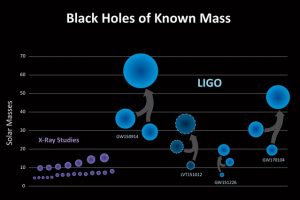
The black-hole masses for the three confirmed detections by LIGO (GW150914, GW151226, GW170104), and one lower-confidence detection (LVT151012). [LIGO/Caltech/MIT/Sonoma State (Aurore Simonnet)]
Next up, Stephanie Juneau (National Optical Astronomy Observatory) discussed supermassive black holes that are shrouded by gas and dust. Even if obscuration hides the black holes, we may be able to see the powerful winds emitted by these giants as they expel material surrounding them. Juneau discussed recent optical observations of the nearby galaxy NGC 7582 by the instrument MUSE on the Very Large Telescope (seen in the cover image at the top of the post). These observations reveal a ring of gas and dust 2,000 light-years in diameter that protects the galaxy from the destructive effects of the wind emitted by the hidden central supermassive black hole. The ring also may serve to focus the wind from the black hole into a more collimated flow. You can read more about these discoveries in the press release here.
Chris Shrader (NASA Goddard Space Flight Center) spoke next about the winds launched from accretion disks surrounding black holes. What drives these winds? The common theory is generally magnetic fields (it’s always magnetic fields, right?). Shrader reported on Chandra observations of the transient X-ray source GRO J1655–40, which went into outburst in 2005. The X-ray spectrum of this source can be well fit by a magnetohydrodynamic model of a black-hole accretion disk, strongly supporting the picture of magnetically driven outflows from these disks.
Lastly, Ethan Vishniac (Johns Hopkins University and the American Astronomical Society) followed up on Shrader’s presentation by discussing how magnetic fields might move around in black-hole accretion disks. The disks suck in fields from the surrounding universe (along with the gas feeding the disk), but turbulence within the disk is then expected to mix everything up. How does an ordered field result from this mess? Vishniac and collaborators’ work suggests that the primary effect at work is buoyancy. As the magnetic fields are compressed and stretched by turbulence, gas is squeezed out of the compressed regions. These sections then become lighter without the weight of the gas dragging them down, which causes them to rise. This buoyancy is what drives the motions of the magnetic fields within accretion disks.
Annie Jump Cannon Award: Origins of Inner Solar Systems (by Susanna Kohler)
This year’s winner of the Annie Jump Cannon award is Rebekah Dawson of Penn State University, “for her work modeling the dynamical interactions of exoplanets in multiplanet systems.” Dawson spoke today about what inner solar systems — i.e., regions of planetary systems closer to their star than Earth is to the Sun — can tell us about how planetary systems form and evolve.
Cannon Prize lecturer @bekkidawson at #aas230 on inner solar systems – just about every known exoplanetary system is one. #PlanetParty!
— Charles Liu (@chuckliu) June 5, 2017
In particular, Dawson discussed what we can learn about the formation of different types of exoplanets based on the properties we observe. One common type of inner solar system planet — which our own solar system oddly doesn’t contain — is super-Earths. Super-Earths come in two different varieties: low-density “mini-Neptunes”, and rocky super-Earths. Dawson’s simulation and statistical work reveals that these two types of planets likely form via two different modes:
- Mini-Neptunes likely form before gas has cleared out of the inner solar system. The presence of gas causes the large sizes and low densities of the planets that form in it, and it also damps the extreme aspects of their orbits, causing the planetary systems to be tightly spaced with flat and circular orbits.
- Rocky super-Earths form after the gas disk has mostly been cleared. The planets have higher densities and smaller radii, and they form with mutually inclined and eccentric orbits that are more widely spaced.
Dawson hopes that the work that she and other researchers are doing studying and modeling inner solar systems will help us to build a unified blueprint for the origins of planetary systems. Such a blueprint would describe how initial conditions (i.e., the disk properties) trigger different physical processes, leading to the diversity of orbits and compositions observed today. From current observations of inner solar systems, we will therefore be able to understand how planetary systems formed.
Dawson has organized a meeting-within-a-meeting at AAS 230 titled Inner Solar Systems, in which speakers are examining a number of open questions about planetary system origins:
#aas230 Amazing line-up of exoplanet experts – faces of the future: pic.twitter.com/LnwDfga9mw
— Meg Urry (@Meg_Urry) June 5, 2017
You can read more about Dawson and her work in an interview by Bhawna Motwani.
Press Conference: Hot Planets & Cool Dwarfs (by Benny Tsang)
The second press conference of the day was on hot planets and cool stars, and the boundary between the two. We had four speakers presenting three exciting pieces of work. Scott Gaudi (Ohio State University) and Karen Collins (Vanderbilt University) first talked about the discovery of a gas-giant planet that is hotter than most stars. They are part of a collaboration called KELT — an all-sky survey for transiting planets around bright stars. KELT-9b is a gas giant planet orbiting around a hot star. It has 3x the mass and 2x the size of Jupiter. The planet is tidally locked to its host star, with a day-side temperature of ~7,800 ℉ (just slightly cooler than the Sun’s ~9,800 ℉). Another exotic aspect of this planet is that its orbit is perpendicular to the host star’s equator. Given the brightness of this system, it has tremendous prospects for more detailed studies! [Full press release]
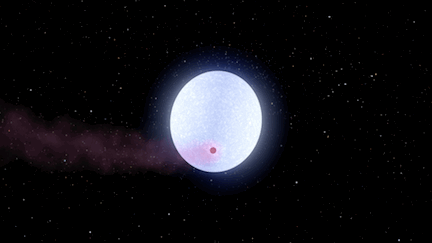
Artist’s animation of KELT-9b, the hottest gas giant observed so far, orbiting its host star. Click to watch the animation! [NASA/JPL-Caltech]
For decades, astronomers weren’t quite certain where the line between stars and planets was. Below a certain mass limit, the central temperature of a cloud of gas is not high enough to ignite hydrogen fusion, which results in objects known as brown dwarfs (a.k.a. failed stars). By observing binary star–planet systems, Trent Dupuy (the University of Texas at Austin) was able to make the first empirical constraint on this minimum mass limit. It is found that the minimum mass for stars to shine is ~70x the mass of the Sun, which is lower than the commonly quoted value of 75x. It implies that we actually have more stars in the Universe, i.e. more hosts for life! [Full press release]
Plenary Session: The Universe’s Most Extreme Star‐Forming Galaxies (by Benny Tsang)
Prof. Caitlin Casey (University of Texas, Austin) is much more than an exceptional scientist and educator, she is also the driving force of many efforts on equity and inclusion. She started the plenary session by welcoming everyone to the great city of Austin! Her talk was on the most actively star-forming galaxies in the Universe. Our Milky Way Galaxy typically makes about one solar mass worth of stars per year, but these extreme galaxies make up to more than a thousand times more stars per year! Stars are the fundamental building blocks of the Universe, and understanding these extreme galaxies helps us put together a complete picture of galaxy growth in the context of cosmology.
It turns out these productive stellar nurseries in the early Universe are very dusty. In these Dusty Star-Forming Galaxies (DSFGs), almost all visible starlight is absorbed by the dust and gas of the interstellar space. By focusing our attention to longer wavelengths, we pick up signatures from the assembly of early galaxies which are otherwise unavailable. It actually came as a surprise when astronomers observed galaxies in millimeter wavelengths and found that they are really luminous! The bright millimeter emission comes from the re-emitted radiation from stars by dust, which closely relates to how active star formation is in these galaxies.
In the talk Casey summarized her endeavor to answer three pressing questions.
- What physics drive DSFGs’ extreme luminosities?
Answer: When the Universe was young, galaxy mergers seemed to be commonplace. Through the challenging work looking into the morphology (appearance) and kinematics (gas motion) of the galaxies, it seems like most DSFGs are merger-driven, although there are some puzzling counterexamples. - How common are DSFGs in the early Universe?
Answer: They appear quite early in the Universe. We need better census of DSFGs, especially during the epoch reionization, to better understand the formation of the first generation of stars and the gas from which they were born. -
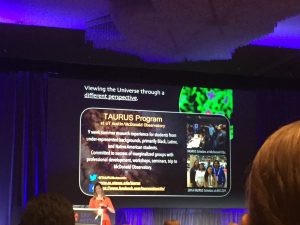
Casey talks about the TAURUS program, a pioneering program with the aim of viewing the Universe through an inclusive perspective.
Where do DSFGs live? (How can we leverage them to learn about the assembly of galaxies in the cosmological context?)
Answer: They mostly live and grow at the densest nodes of the cosmic web. In fact more DSFGs were found in the dense nodes than expected. Again we need better observational constraints on the collapse and build-up of large scale structures.
“We don’t understand galaxy formation and evolution until we understand gas and dust”, she remarked and motivated for a more comprehensive mapping of gas and dust in the Universe. After all, they are what stars and galaxies are built from.
Casey is also the leader of the TAURUS program, a 9-week, one-on-one summer research and mentorship program for underrepresented students here in Austin. To learn more, you can check out her interview by Gourav Khullar.
Plenary Session: Science Highlights from SOFIA (by Susanna Kohler)
The final plenary of the day was given by Erick Young of the Universities Space Research Association (USRA), here to tell us about the latest science highlights from the SOFIA mission.
Young: "SOFIA is flying — and it has a hole in the side of it the size of a garage door. I find that a remarkable accomplishment." #aas230 pic.twitter.com/WdjHkPhrD0
— AAS Nova (@AASNova) June 5, 2017
SOFIA, or the Stratospheric Observatory For Infrared Astronomy, is a 2.5-m telescope and a collection of instruments flown on a Boeing 747SP wide-body aircraft, allowing scientists to make infrared astronomical observations at an altitude of about 41,000 ft — i.e., above the majority of the water vapor in the Earth’s atmosphere.
What science has been done with SOFIA? It’s used to study a broad range of topics, but Young argues that its science goals can generally be distilled to one line: SOFIA explores the life cycle of matter in galaxies. Young spent the remainder of the talk presenting specific observations and discoveries made with SOFIA. A few examples include:
- Mapping of the galaxy M51 — in particular, looking at the development and formation of stars in the galaxy’s spiral arms.
- Observations of the dust clumps in the Circumnuclear Dust Ring at the center of our galaxy. These clumps are too tenuous to survive a complete orbit, so they must be somehow regenerated.
- Observations of dust in a supernova remnant only 10,000 years old. These data suggest that supernovae might be the primary contributor of the dust observed in distant galaxies in the very early universe.
- A look at gas infall as a cloud collapses to form stars. SOFIA data allows us to map out the geometry and dynamics of this process better.
- Occultation measurements of a star by Pluto, which allowed us to learn about Pluto’s atmosphere before New Horizons arrived. SOFIA will try to repeat this feat next month by observing an occultation of the Kuiper Belt Object MU69, New Horizons’s next target.
SOFIA’s missions are user-driven, with the community of infrared astronomers submitting proposals for new targets to study. In addition, the observatory serves as an excellent platform for infrared instrument development. Young’s talk clearly demonstrated that SOFIA’s wide array of instruments and unique follow-the-science mobility has produced a broad range of results that wouldn’t have been possible with a traditional ground-based facility.
You can read more about Young and his work in an interview by Amber Hornsby.

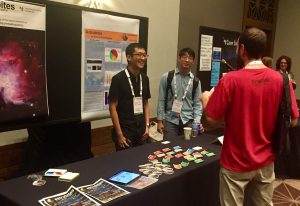
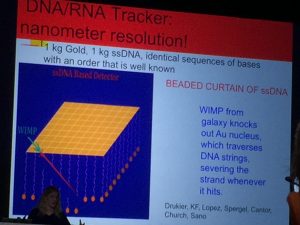

8 Comments
Pingback: AAS 230: Day 1 – MeasurementDataBases for Industry & Science
Pingback: Day 1 AAS
Pingback: Von den Pressekonferenzen der 230. AAS-Tagung | Skyweek Zwei Punkt Null
Pingback: What Makes a Star a Star? | Techsemut English
Pingback: What makes a star a star? - Science Fans
Pingback: What makes a star a star? - Science News
Pingback: What makes a star a star? - New Now Science
Pingback: What Makes a Star a Star? | Etienne et Noelle